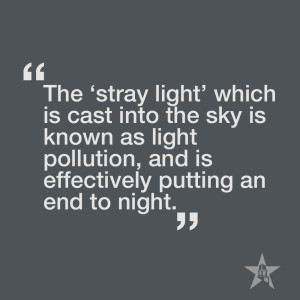I was six the first time I saw a meteor shower. I woke up at around midnight to my sister shaking my shoulder and pointing to the window where hundreds of lights were zipping across the blackness of night. I remember running outside and staring into the sky, even long after the meteors had stopped their frenzied flight. My half-sister from Chicago was with us, and she remarked that she had never seen so many stars in her life: sadly, there are not many places left with skies as dark as my rural New York hometown.
 If you look at a satellite picture of the world at night, you will see what seems like an endless number of lights peppering the landscape, concentrating most thickly in the U.S. Each point shows the artificial light thrown from street lamps and buildings in various cities. This “stray light” which is cast into the sky is known as light pollution, and it is effectively putting an end to night.
If you look at a satellite picture of the world at night, you will see what seems like an endless number of lights peppering the landscape, concentrating most thickly in the U.S. Each point shows the artificial light thrown from street lamps and buildings in various cities. This “stray light” which is cast into the sky is known as light pollution, and it is effectively putting an end to night.
Not only does darkness allow us to gaze at the stars, it is essential to the life and health of many creatures. When baby sea turtles hatch on the beach, they do so under the cover of night and are guided to the water by the bright horizon over the ocean. Millions of hatchlings die each year because they are drawn away by artificial lights. Migratory birds often travel by night and navigate using moonlight and starlight. Artificial lights can confuse them and cause them to veer off course, often into brightly illuminated buildings.
Animals are not the only ones who suffer from this unnatural situation. In 2012, the American Medical Association stated that “many species (including humans) need darkness to survive and thrive.” Humans have an inner clock (or circadian clock) which tells us when to sleep and is governed by light and darkness. The hormone melatonin is essentially what puts us to sleep at night, and it functions best in complete darkness. When we are exposed to unnatural light during the night, our bodies have trouble detecting whether it’s time to sleep or time to be awake.
According to an article in the journal Environmental Health Perspectives, “disruption of the circadian clock is linked to several medical disorders in humans, including depression, insomnia, cardiovascular disease, and cancer.” Artificial lights allow us to stay awake much farther into the night than our ancestors were ever capable of, and the orange glow from cities make it impossible to ever truly experience dark nights. Much like the baby turtles and the migratory birds, humanity is experiencing the negative effects of light pollution.
Light pollution is an issue which, on the surface, may seem impossible to resolve. After all, our culture has been dependent on artificial lighting for over a hundred years. Fortunately, however, this is not a matter of powering down our buildings and streetlamps and returning to candlelight. On the individual level, we can help by closing our blinds at night to keep the lights inside our homes from throwing light pollution into the sky. We can also become more conscious of turning off unused lights, which has the added benefit of cutting energy costs. On a larger scale, specialized outdoor lighting has been developed that reduces the glare cast by inefficient streetlights. This type of lighting has been proven to increase visibility while simultaneously shielding the sky from stray light.
 Overall, Houghton’s campus does not drastically add to the problem of light pollution: our campus is small and the light sources we use tend to be more environmentally friendly. For instance, the specialized dome shape lights, which reduce glare, are used around campus. However, the simple task of turning off indoor lighting when a building is closed should be better enforced. Multiple facilities around campus, such as the music building and the athletic fields, should become more conscious of the light pollution they cause. The KPAC light emission can be seen from a far distance and this must change. Our campus should make these small steps and more in order to effectively decrease light pollution.
Overall, Houghton’s campus does not drastically add to the problem of light pollution: our campus is small and the light sources we use tend to be more environmentally friendly. For instance, the specialized dome shape lights, which reduce glare, are used around campus. However, the simple task of turning off indoor lighting when a building is closed should be better enforced. Multiple facilities around campus, such as the music building and the athletic fields, should become more conscious of the light pollution they cause. The KPAC light emission can be seen from a far distance and this must change. Our campus should make these small steps and more in order to effectively decrease light pollution.
The stars have fascinated humanity for thousands of years, giving inspiration to folktales, poetry, and backyard stargazing. The night sky is part of our culture, part of our heritage. As it disappears, it takes with it the possibility that our grandchildren will ever experience the sight of the Milky Way or the splendor of a meteor shower. What would the world be like after the death of night?
